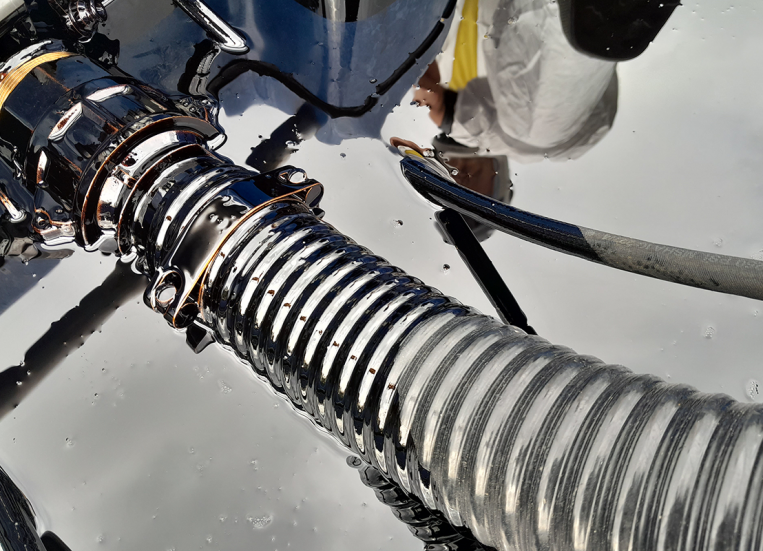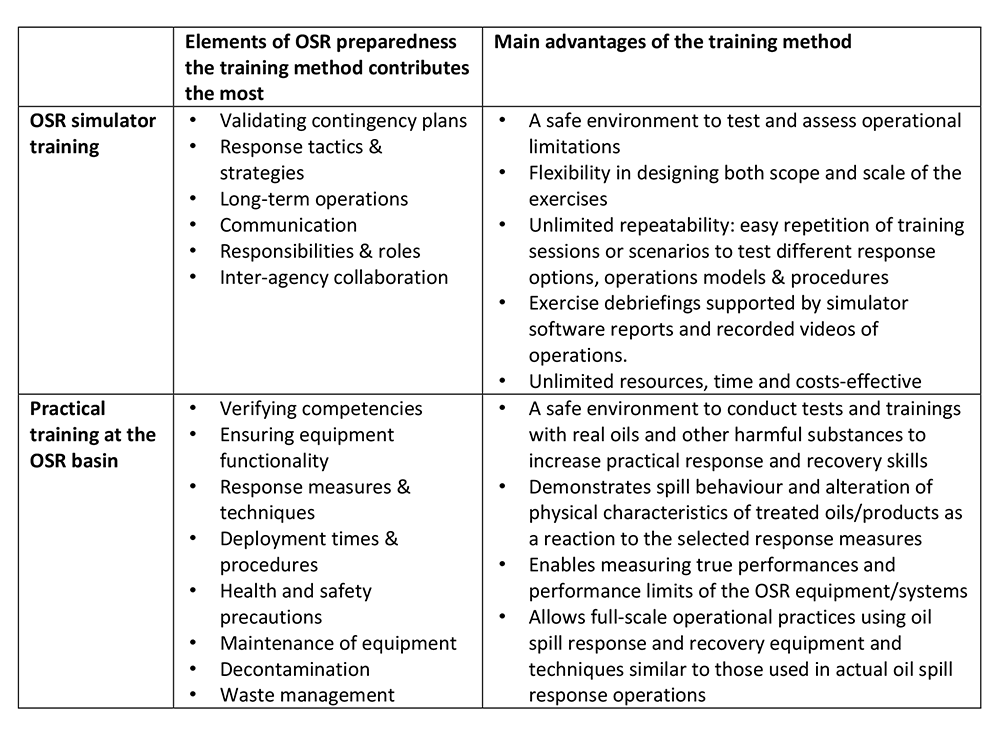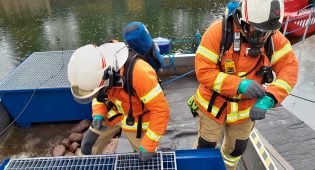Oil spill response training environments complement each other
16.10.2023South-Eastern Finland University of Applied Sciences (Xamk) has developed two training environments for oil spill response: an oil spill response basin and simulator training. These environments complement each other as they provide different skills.
Oil spill response is a specialised task that requires regular training to maintain the necessary competencies. Different exercises are used to practice a specific skill or train a particular component of the Oil Spill Response (OSR) contingency plan.
The more varied the exercises used, the wider the coverage of the response operation can be obtained, as different exercises serve different purposes. This article explores the differences between simulator exercises and hands-on drills.
With or without mobilising equipment
OSR exercise types are generally divided into discussion-based and operations-based exercises, the former represented by workshops and tabletop exercises and the latter by drills and equipment deployment exercises (Figure 1). These exercise types can be considered as building blocks which, when combined, form an effective exercise programme. (Leonard & Roberson 1999; IPIECA & IOGP 2014; Halonen & Altarriba 2019.)
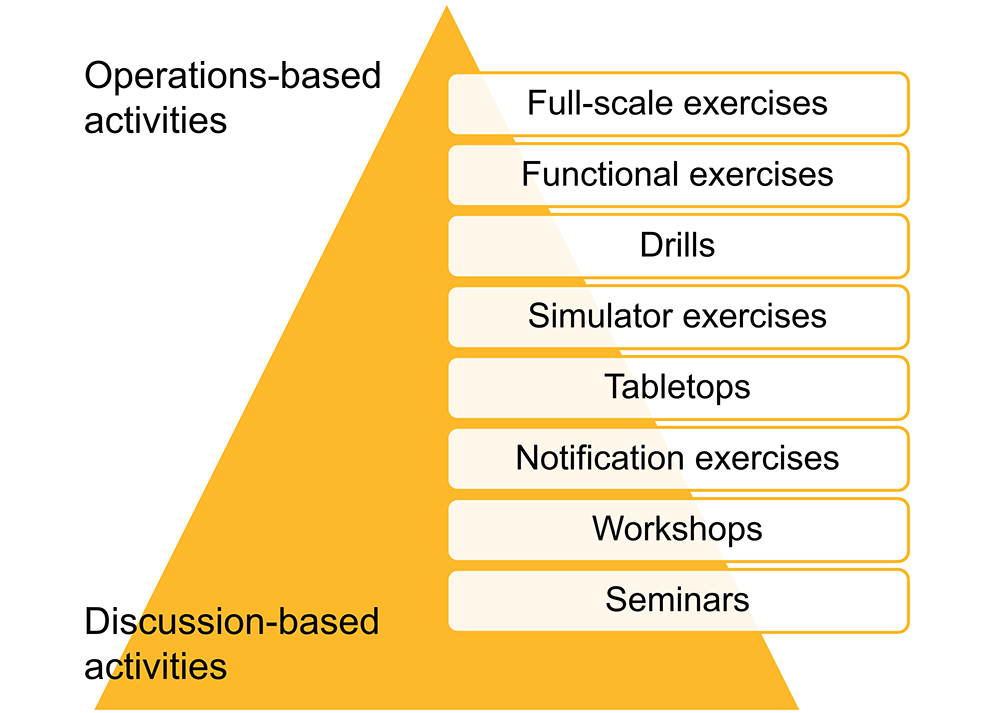
Operations-based exercises are useful for testing the functioning of equipment, techniques and procedures, whereas discussion-based allow contingency plans to be assessed at a more strategic level (IPIECA & IOGP 2014; Halonen 2018a; Halonen & Altarriba 2019).
The four types of exercises at the bottom of the pyramid in Figure 1 do not impose any requirements on the physical environment. The top four, on the other hand, can only be performed in a specific setting or platform and with designated equipment.
Full-scale exercises, functional exercises, and drills require mobilisation of spill response troops and equipment. Simulator exercises are carried out using virtual resources. Tabletops, notification exercises and seminars can be conveniently organised even remotely.
Simulator training has almost limitless possibilities
The OSR simulator training provided by Xamk utilises a navigational bridge simulator accredited for STCW seafarers training. The simulator consists of three full-scale bridges and eight workstations, one aircraft interface (which can be used as a helicopter or a drone) and a separate bucket skimmer simulator for oil recovery. The number of bridges will increase when the maritime simulator centre moves to the new campus in 2024.
The simulator software has been upgraded with an Oil Spill Functionality Module that enables the use of booms and oil recovery units. It also models the behaviour of the oil, the spread and drift of the spill, and how actions or response measures are likely to affect the oil. Other objects are also interactive, meaning that, for example, weather impacts and boom failures can be demonstrated.
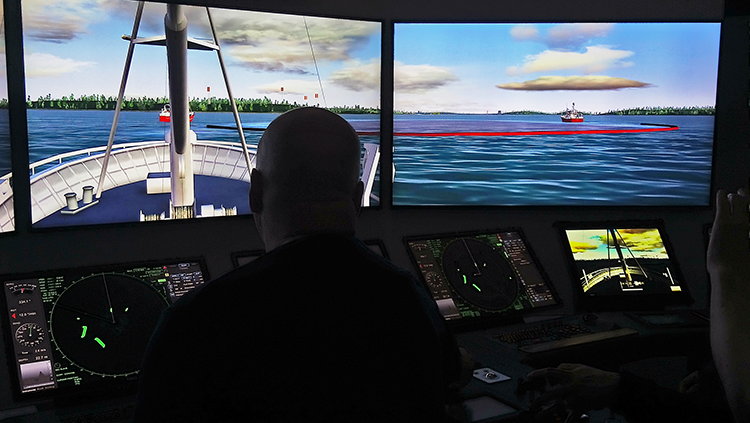
In addition to vessel handling and safe navigation exercises, full-scale bridges are suitable for training many response-related activities, such as reconnaissance, boom deployment and towing in pairs or multi-vessel configurations. Simulation training has also increased communication skills and understanding of the perspectives of those involved in other roles. (Halonen 2018b.)
One of the advantages of simulation is that you can create an incident scenario in any location at a chosen scale. This can be used to test the adequacy of the available equipment to tackle specific spill volumes or longer-term operations. Training missions can also be easily repeated several times to compare different approaches and tactics. (Halonen 2018b.) A simulation can, therefore, be used to validate and develop contingency plans by demonstrating what can be achieved with the selected resources and where the potential gaps lie (Halonen 2018b; Halonen & Altarriba 2019).
Hands-on training at Oil spill response test basin
Xamk’s Oil spill response testing facility is a controlled environment where real oil products can be used. The facility has a major test basin, a water channel, and several smaller test tanks.
The three-metre-deep main basin is about 30 metres in diameter, giving it a surface area of 660 square metres. These dimensions allow the deployment of full-size equipment so that the equipment used for training can be similar to that used in real incidents.
The water channel is used for response demonstrations in flowing waters and response measures in rivers and ditches. Smaller test tanks are used for on-water and onshore oil recovery measures and soil units to demonstrate land-based spills.
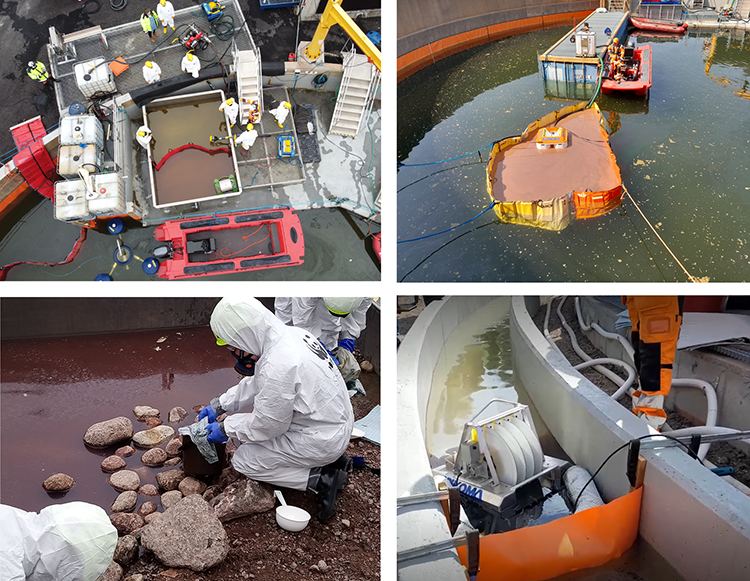
Turning point in training opportunities
Introducing the basin a couple of years ago changed OSR training considerably. The use of oils has made the training much more effective and in-depth, as only by using real substances can you demonstrate how to operate the equipment correctly. Before the basin was used, exercises were conducted as dry-runs without target substances or with peat or other similar materials.
The basin has proved useful for practising oil containment and recovery techniques and for adopting safe working practices. The need to consider the hazardous properties of spilled substances and contaminated material is now evident during each exercise. This is in direct contrast to previous training formats. The basin provides an opportunity to practice elements that were often excluded from traditional exercises and drills, such as proper and systematic decommissioning of equipment and decontamination.
Added to health and safety precautions, the prevention of secondary contamination of the environment is a primary learning objective. Although the training environment itself is designed so that no environmental pollution is caused, even if an accidental spillage occurs. All training areas are either inside the basin or constructed in such a way that the oil remains in an enclosed area. However, the aim of the exercises is to ensure that all measures are implemented in such a way that they can be applied in a real incident situation in a natural environment.
Comparing the training methods
Both of the training environments continue to prove their relevance. Simulator training is more effective in validating broader concepts and entities like the contingency plans as a whole or the response operation from a tactical and strategic perspective. In contrast, hands-on training improves the technical competence of personnel and validates the actual performance of equipment.
Table 1. Comparison of training environments’ advantages and effectiveness in improving oil spill response (OSR) capabilities.
A simulation is more useful for training non-technical skills, such as communication and becoming familiar with the roles and responsibilities of a wider group of actors. On the other hand, practical training provides measurable data, for example, on mobilisation or boom deployment times, which also serve as reality checks for contingency planning. These values are also useful in tabletop exercises for realistic progress and transitions.
Even when carried out in a controlled environment, hands-on training closely mirrors an actual incident situation, raising awareness of safety requirements and concretising the actions required to deal with contaminated equipment and the spilt substance itself.
References
Halonen, J. 2018a. Öljyntorjunnan harjoitussuunnittelu Saimaan alueella. In: Öljyntorjunnan toimintamallin kehittäminen Saimaan syväväylälle. SÖKÖSaimaa-hankkeen taustaselvitykset ja loppuraportti. Halonen, J. (ed.) Xamk Kehittää 64. Kaakkois-Suomen ammattikorkeakoulu, Kotka, pp. 539–563.
Halonen, J. 2018b. Öljyntorjuntaa simulaatioympäristössä. In: Liikkeellä, Toimintaa ja tuloksia Logistiikan ja merenkulun tutkimus- ja kehitystoiminnasta. Halonen, J. & Potinkara, P. (Eds.) Xamk Kehittää 60. Kaakkois-Suomen ammattikorkeakoulu, Kotka, pp. 100–109.
Halonen, J. & Altarriba, E. 2019. Improving Preparedness for Shipborne Oil Pollution – Highlights of Tabletop Exercises at Saimaa Inland Waters. In: TransNav, the International Journal on Marine Navigation and Safety of Sea Transportation, Vol. 13, No. 1, pp. 221–228. DOI: 10.12716/1001.13.01.23
IPIECA & IOGP 2014. Oil spill exercises. Good practice guidelines for the development of an effective exercise programme. IOGP Report 515.
Leonard, J. J. & Roberson, M. 1999. Adding realism to tabletop exercises. In: International Oil Spill Conference Proceedings 1999, pp. 555–560.
































